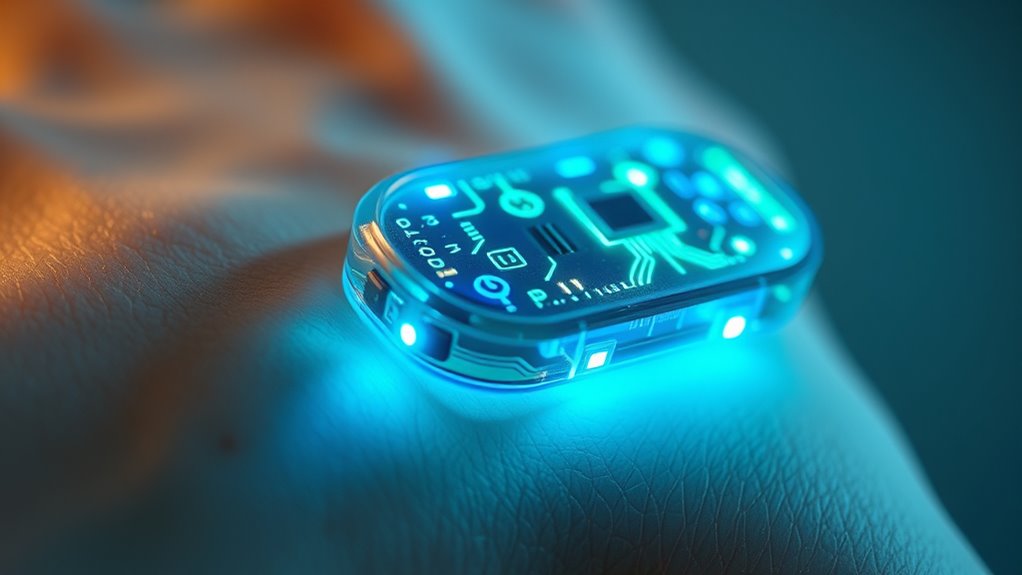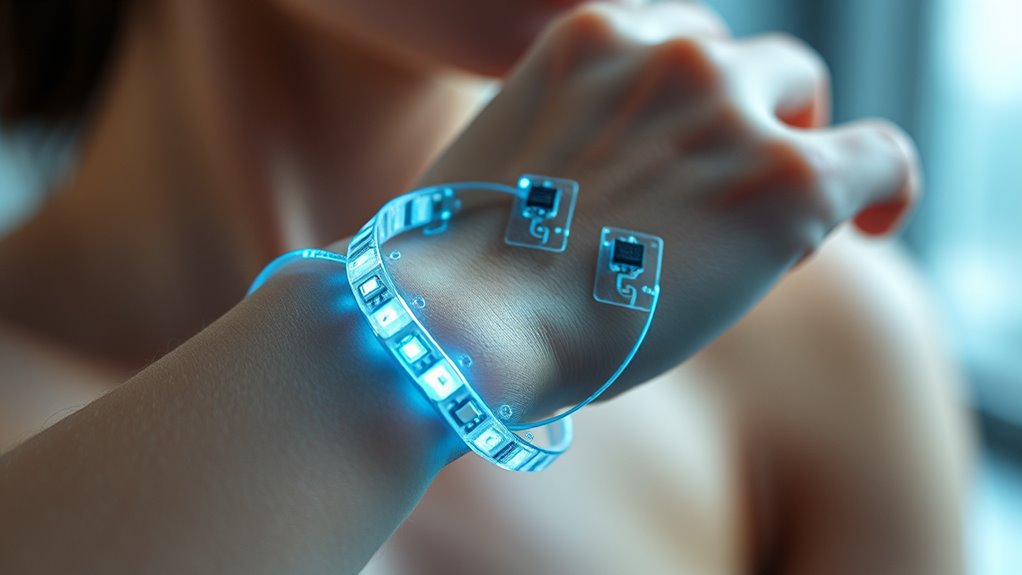Wearable nanotech devices incorporate advanced materials and nanoscale sensors into everyday accessories, offering real-time health insights with durability that lasts. They seamlessly measure essential signs like heart rate, oxygen levels, and stress, while resisting corrosion and environmental wear. Designed for comfort and longevity, these devices adapt to your active lifestyle. If you want to discover how this cutting-edge technology can transform your health monitoring, there’s more to explore ahead.
Key Takeaways
- Wearable nanotech devices enable real-time, non-invasive health monitoring through embedded nanoscale sensors.
- Advanced materials ensure durability and resistance to environmental factors, supporting long-term use.
- Integration into fabrics, patches, or lenses allows seamless, natural interaction with daily activities.
- These devices provide detailed, continuous data on physiological parameters like heart rate and hydration.
- Their durability and precision improve reliability for health, fitness, and performance optimization.

Wearable nanotech devices are revolutionizing how you monitor health, enhance performance, and interact with technology on a daily basis. These tiny yet powerful tools are seamlessly integrated into your everyday life, providing real-time data and personalized insights that were once out of reach. At the core of their innovation lies nanotech durability, ensuring that these devices can withstand the rigors of daily use without compromising performance. Whether you’re exercising outdoors, working in challenging environments, or simply going about your routine, nanotech durability guarantees that your wearable devices stay reliable and intact over time. This resilience is achieved through advanced materials that resist wear and tear, corrosion, and environmental factors, making these devices a long-lasting companion in your health and fitness journey. The development of high-quality materials plays a crucial role in enhancing both durability and sensor accuracy in wearable nanotech devices. Sensor integration is another key aspect that makes wearable nanotech devices so effective. These devices are equipped with an array of tiny sensors that can measure a multitude of physiological parameters—heart rate, blood oxygen levels, hydration, and even stress levels—often all within a single compact unit. The integration of sensors at the nanoscale allows for unparalleled sensitivity and accuracy, giving you detailed insights that can inform your health decisions instantly. Because sensors can be embedded directly into fabrics, skin patches, or even contact lenses, the interaction feels natural and unobtrusive. This high level of integration also means that data collection is continuous and non-invasive, providing a detailed picture of your wellbeing without disrupting your daily activities.
Frequently Asked Questions
How Long Do Wearable Nanotech Devices Typically Last Before Needing Replacement?
You can typically expect wearable nanotech devices to last between 1 to 5 years, depending on their device durability and how often you use them. The lifespan expectancy varies based on the materials and technology involved, but regular maintenance can prolong their usability. Keep an eye on battery life and functionality, and replace them when performance declines to ensure you get the most out of your investment.
Are Wearable Nanotech Devices Safe for Long-Term Use?
Yes, wearable nanotech devices are generally safe for long-term use, but you should stay cautious. Think of them as tiny guardians working silently on your behalf. While biocompatibility concerns are addressed through advanced materials, ethical considerations still hover like a cautious sentinel. Regular check-ups and staying informed help guarantee these devices serve you safely, providing peace of mind as they enhance your life without unintended consequences.
Can Wearable Nanotech Devices Be Customized for Individual Needs?
Yes, wearable nanotech devices can be customized for your individual needs. They often offer personalization options, allowing you to tailor settings and features to suit your health goals, lifestyle, or preferences. Thanks to their adaptive functionality, these devices can learn from your habits and make real-time adjustments, ensuring peak performance. This customization enhances user experience, making nanotech wearables more effective and comfortable for long-term use tailored specifically to you.
What Are the Privacy Implications of Using Nanotech Wearables?
Did you know that over 70% of users worry about data security when using wearable tech? With nanotech wearables, your personal privacy faces significant risks, as sensitive health data could be vulnerable to hacking or unauthorized access. You need to be cautious and guarantee strong data security measures are in place. Protecting your personal information is essential to prevent misuse and maintain trust in these innovative devices.
How Do Wearable Nanotech Devices Communicate With Other Technology?
You use wireless protocols like Bluetooth or Wi-Fi to make your nanotech wearables communicate with other devices. These devices transmit data through encrypted channels, ensuring your information stays secure from unauthorized access. As you move or perform activities, the nanotech device continuously exchanges data with your smartphone, computer, or other connected tech, allowing seamless integration and real-time updates while maintaining privacy through robust encryption methods.
Conclusion
As you embrace wearable nanotech devices, you’re stepping into a future where technology becomes an extension of yourself, like a second skin. These tiny marvels are the keys to revealing your full potential, turning everyday moments into extraordinary experiences. With each innovation, you’re weaving a tapestry of endless possibilities, where the boundaries between human and machine blur. So, gear up and let these nanotech wonders guide you into a brighter, smarter tomorrow—where you truly become the master of your own destiny.









